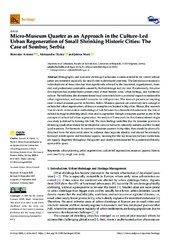Приказ основних података о документу
Micro-Museum Quarter as an Approach in the Culture-Led Urban Regeneration of Small Shrinking Historic Cities: The Case of Sombor, Serbia
| dc.creator | Antonić, Branislav | |
| dc.creator | Djukić, Aleksandra | |
| dc.creator | Marić, Jelena | |
| dc.date.accessioned | 2023-10-05T11:34:00Z | |
| dc.date.available | 2023-10-05T11:34:00Z | |
| dc.date.issued | 2023 | |
| dc.identifier.issn | 2571-9408 | |
| dc.identifier.uri | https://raf.arh.bg.ac.rs/handle/123456789/1320 | |
| dc.description.abstract | Demographic and economic shrinkage has become a common trend in the current urbanisation environment, especially for small cities in developed countries. The desired socio-economic redevelopment of these cities has been significantly affected by the functional, organisational, financial, and professional constraints caused by both shrinkage and city size. Paradoxically, this slow development has enabled better preservation of their historic cores, urban heritage, and traditional culture. Nevertheless, the aforementioned local constraints have a profound impact on sustainable urban regeneration, and successful examples are still quite rare. This research presents an inspiring case—a small museum quarter in Sombor, Serbia. Museum quarters are a relatively new concept in culture-led urban regeneration; all known examples are located in big cities. Hence, this research tries to create an innovative methodological link between two theoretical fundaments: the role of cultural heritage in shrinking small cities and its expression through a museum quarter as one of the concepts of culture-led urban regeneration. An analytical framework for the aforementioned single case study is derived by forming this link. The main findings underline that the museum quarters in shrinking small cities should be developed in a micro-format to rationally address and the limited local resources. Furthermore, in contrast to museum quarters in big cities, they should be physically detached from the main retail street to enhance their separate identity and should be internally balanced in both spatial and functional aspects, meaning that the key museum/cultural institutions are equally dispersed throughout the quarter and clearly interconnected by a pedestrian-friendly open public space. | sr |
| dc.language.iso | en | sr |
| dc.publisher | MDPI | sr |
| dc.rights | openAccess | sr |
| dc.rights.uri | https://creativecommons.org/licenses/by/4.0/ | |
| dc.source | Heritage | sr |
| dc.subject | Urban planning | sr |
| dc.subject | urban regeneration | sr |
| dc.subject | culture-led regeneration | sr |
| dc.subject | museum quarter | sr |
| dc.subject | historic core | sr |
| dc.subject | small city | sr |
| dc.subject | single case study | sr |
| dc.title | Micro-Museum Quarter as an Approach in the Culture-Led Urban Regeneration of Small Shrinking Historic Cities: The Case of Sombor, Serbia | sr |
| dc.type | article | sr |
| dc.rights.license | BY | sr |
| dcterms.abstract | Aнтонић, Бранислав; Дјукић, Aлександра; Марић, Јелена; | |
| dc.rights.holder | MDPI | sr |
| dc.citation.volume | 6 | |
| dc.citation.issue | 10 | |
| dc.citation.spage | 6616 | |
| dc.citation.epage | 6633 | |
| dc.identifier.doi | 10.3390/heritage6100346 | |
| dc.identifier.fulltext | http://raf.arh.bg.ac.rs/bitstream/id/4578/heritage-06-00346.pdf | |
| dc.type.version | publishedVersion | sr |

